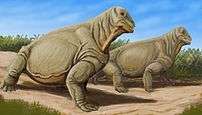Moschops
| Moschops Temporal range: Capitanian, 265–260 Ma | |
|---|---|
 | |
| Mounted skeleton | |
| Scientific classification | |
| Kingdom: | Animalia |
| Phylum: | Chordata |
| Clade: | Synapsida |
| Order: | Therapsida |
| Suborder: | †Dinocephalia |
| Family: | †Tapinocephalidae |
| Genus: | †Moschops Broom, 1911 |
| Type species | |
| †Moschops capensis Broom, 1911 | |
| Species | |
| |
| Synonyms | |
| |
Moschops (Greek for "calf face") is an extinct genus of therapsid that lived in the Guadalupian epoch, around 265–260 million years ago. Therapsids are synapsids, which were at one time the dominant land animals. Its remains were found in the Karoo region of South Africa.
Description

Moschops was a roughly 2.7-metre-long (8.9 ft), massively built dinocephalian.[1] It had a short, thick and massive head, which was broad across the orbits. Like other members of Tapinocephalidae, the skull had a tiny opening for the pineal organ.[2] The occiput was broad and deep, but the skull was more narrow in the dorsal border. Furthermore, the pterygoid arches and the angular region of the jaw were quite heavy, allowing the insertion of strong jaw muscles. Due to that and because it possessed long-crowned, stout teeth, it is believed that Moschops was a herbivore feeding on nutrient-poor and tough vegetation, like cycad stems. Due to the presumably nutrient-poor food, it very likely had to feed for a very long time. Its anatomy allowed Moschops to open its elbow joint more widely, enabling it to move in a more mammal-like way than the other crawlers in its time. That might have helped it to carry its massive body more easily while feeding.[1] Very likely, most dinocephalians were rather slow-moving animals, but capable of raising themselves, for short bursts.[3] It is also possible that Moschops and other dinocephalians were semiaquatic, given the heavy build and the limbs with their spreading hands and feet. The heavy head could have been useful for diving after food.[1]
Moschops had a thick skull, prompting speculation that individuals competed with one another by head-butting.[4] Some doubt whether the Moschops were born with thick skulls. If they were, then Moschops' short, heavy tail may have counterbalanced the weight of its head. Its main enemies were very likely titanosuchids and the larger therocephalians.[1]
Earliest finds
Moschops material was discovered for the first time by Robert Broom in the Ecca Group (part of the Karoo Supergroup) in South Africa. The geological horizon dubious, it was referred to that group on the basis of Pareiasaurus remains in the near. The material includes a holotype (AMNH 5550) and seven topotypes (AMNH 5551-5557). The degree of pachyostosis varies within the skulls of the specimens. According to Broom, it is because of gender and age variation within the discovered specimens. In 1910, the material was sent to the American Museum of Natural History in New York City and it was described in 1911.[1]
Classification
Moschops is characterized by a strongly pachyostosed skull with a broad intertemporal region and greatly reduced temporal fossae. Two species are known from good fossil record, M. capensis and M. koupensis. Two other species were assigned (M. whaitsi and M. oweni), but the validity is doubtful.
Genera regarded as synonyms are Moschoides, Agnosaurus, Moschognathus and Pnigalion.
Another taxon, Delphinognathus conocephalus, could have been a synonym also, as it could represent a juvenile Moschops. This taxon is known from a single, moderately pachyostosed skull. It has a conical boss on the parietal surrounding the pineal foramen.[5]
In popular culture
The Moschops genus was fictionalized in a stop motion-animated television series called Moschops (1983); in the video game Carnivores (1998), developed by Action Forms; and in an animated short film by Jim Trainor called The Moschops (1999).[6]
See also
References
- 1 2 3 4 5 William, Gregory (1926). "The skeleton of Moschops capensis, a dinocephalian reptile from the Permian of South Africa". Bulletin of the American Museum of Natural History. 56 (3): 179–251.
- ↑ The Age of Reptiles
- ↑ Haughton, S. H. (1919). "A Review of the Reptilian Fauna of the Karroo System of South Africa". Transactions of the Geological Society of South Africa. 22: 14.
- ↑ Herbert R. Barghusen (1975). "A Review of Fighting Adaptations in Dinocephalians (Reptilia, Therapsida)". Paleobiology. 1 (3): 295–311. JSTOR 2400370.
- ↑ Boonstra, L. D. (1969). "The fauna of the Tapinocephalus zone (Beaufort beds of the Karoo)". Annals of the South African Museum. Cape Town. 56 (1): 42.
- ↑ "Watch Moschops, the Animated film by Jim Trainor". Fandor.
External links
| Wikimedia Commons has media related to Moschops. |
- Moschops, pictures and a brief overview
- Tapinocephalidae at Paleos.com


